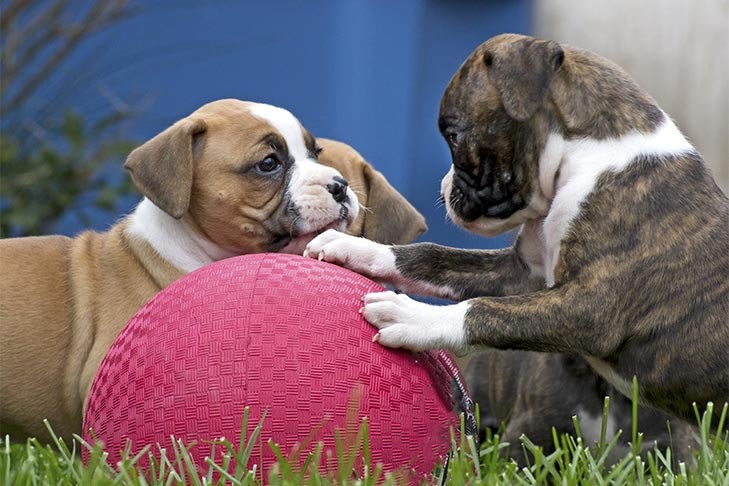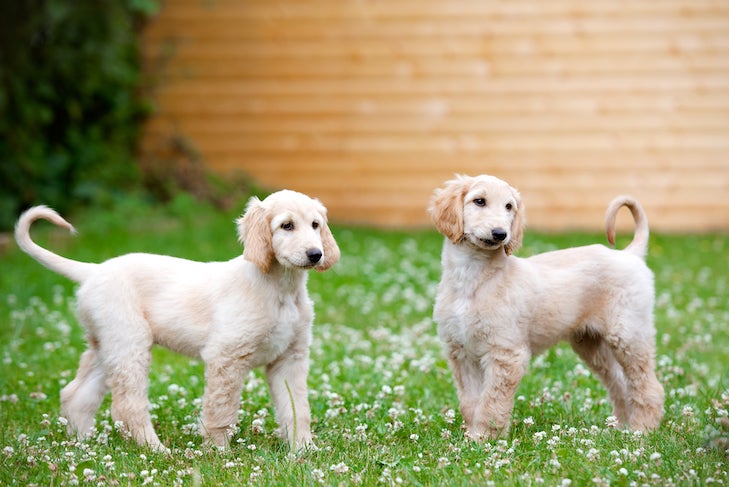Puppies have a critical socialization period that starts around three weeks and goes up to between 12 and 14 weeks. Studies show that a lack of positive interactions during this time can lead to problem behaviors and fearfulness in adult dogs.
Allowing your pup to play with other dogs is a crucial element of proper socialization, and it can also be great fun for them. But if play sessions aren’t managed and introduced carefully, they can do more harm than good.
It’s not uncommon for well-meaning owners to book a place at a one-off—and often chaotic “puppy party”—or to head straight to the local dog park. But that’s not always the right approach.
Instead, it’s best to do your research, both in terms of the class you enroll in and the play dates you arrange. That way, you’ll be setting your puppy up for success.
Not All Puppy Classes Are Equal
When looking for a puppy class, it isn’t necessary to focus on a structured format, teaching just basic commands and obedience.
Casey McGee is the owner of Upward Hound Dog Training and a coach and mentor for Jean Donaldson’s prestigious Academy for Dog Trainers. She emphasizes the importance of positive socialization, supervised off-leash play, and understanding the basics of force-free training methods.
“You have your puppy’s entire life to teach them how to hold a sit-stay. But you only have their first 18 (maybe fewer) weeks to teach them that the world is a safe and happy place,” McGee explains.
McGee advocates off-leash play in a controlled environment. It allows your pup to get feedback on their social skills in real-time from their peers where the cost of mistakes is still relatively low. “Puppies without adult teeth are incapable of seriously hurting each other. With appropriate supervision, nobody will become frightened,” she says.
But supervised, rather than free-for-all, play sessions in a puppy class are crucial. “Shy pups need to be given a chance to watch and absorb rambunctious play vibes. They can then opt in when ready rather than getting repeatedly rolled, bitten, and chased, which will only exacerbate their fears,” says McGee.
Research shows that dogs attending a six-week course, instead of no class or a one-off puppy party, were more likely to respond positively to strangers. It’s also best to complete the course, rather than dropping in and out for a couple of sessions.

Setting Up Puppy Play Dates
As well as attending classes, you might want to set up some puppy play dates with friends who have dogs.
It’s best to start with one-on-one sessions in a neutral and safe environment, with puppies that are well-matched in terms of style of play and size.
Don’t get too caught up in catching up with your friends. Close supervision ensures the dogs will remain comfortable and have fun.
Be An Advocate for Your Pup and Let Them Make Choices
The last thing you want to do when it comes to play sessions is force your pup into it, especially if they’re displaying fearful behavior.
If things are getting rough, and you aren’t sure if your pup is feeling overwhelmed or getting bullied, McGee recommends conducting a consent test.
“Gently hold back the dog who may be coming on too strong, and let the other puppy ‘vote with their feet’,” she suggests. “If they come back right away to initiate more play, then they’re game. If they take that opportunity to get a drink of water, escape, or even just wander away, they need a break.”
Don’t be afraid to advocate for your pup in a class or play date environment. If they’re hiding behind you and another pup keeps coming at them, ask their owner to step in.
McGee also clarifies that it’s okay for them to sit in your lap initially to take things in. “Let them join the fray when they’re good and ready, knowing they can come back to you—their safe spot—whenever they need to check in.”
Understand Your Pup’s Body Language
Another way you can protect your pup is by understanding their body language. As McGee explains, “it’s easy to mistake growling, pinning, wrestling and biting for aggression rather than play. But, most healthy play involves one or more of those activities.”
Subtle signs that your pup is fearful or stressed could include a tucked tail, trembling, hunched posture, pinned back ears, or whale eye. They may also display submissive appeasement gestures. Some common examples include excessive yawning, lip licking, sniffing the ground, or averting their gaze.

Is The Dog Park a Suitable Place For Some Puppy Play?
Although well-managed dog parks can offer benefits for confident adult dogs, they aren’t the best places to introduce young puppies to play.
In addition to the risk of your pup contracting diseases before they have completed vaccinations, controlling the set-up is more challenging. There’s an increased chance of your puppy getting frightened or even injured by overly boisterous adult dogs.
McGee recommends avoiding the dog park until your puppy is at least six months old. “When arguments arise, dogs navigate conflict using a combination of body language signals and non-injurious anti-social behavior such as growling and snarking,” she explains.
“Puppies who have not been previously ‘padded’ with dozens of positive dog experiences may understandably be quite traumatized by these sights and sounds. They can come away thinking that all unfamiliar adult dogs are scary,” says McGee.
“Instead, let them acquire their social skills in a safe environment. If they develop positive associations with other dogs here, when something goes south at the dog park, they’re more likely to be able to shrug it off.”

